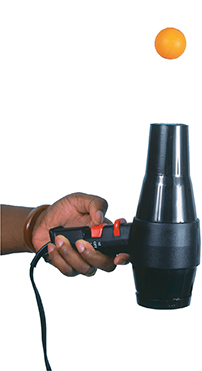13.2 Forces and Pressure in Fluids
Reading Focus
Key Concepts
 How does Pascal's principle describe the transmission of pressure through a fluid?
How does Pascal's principle describe the transmission of pressure through a fluid? How does a hydraulic system work?
How does a hydraulic system work? How is the speed of a fluid related to the pressure within the fluid?
How is the speed of a fluid related to the pressure within the fluid?
Vocabulary
hydraulic system
lift
Reading Strategy
Predicting Copy the table below. Then imagine two small foam balls hanging from strings at the same height with about three centimeters of space between them. Before you read the section, write a prediction about what will happen to the balls when you blow air through the space between them. Identify your reasons. After you have read the section, check the accuracy of your prediction.
Prediction |
a. |
|---|---|
Reason for prediction |
b. |
Suppose your teacher held a table tennis ball on an upward-pointing hair dryer. He then asked you to predict what would happen when the hair dryer was turned on and the ball was released. Did you predict that the ball would be blown up and away? If you did, you were wrong!
As shown in Figure 5, when the hair dryer was turned on, the table tennis ball was not blown away. Instead, it was lifted up and suspended in the air stream above the hair dryer. Suppose your teacher then made the ball bob in the air stream by gently moving the hair dryer up and down. How was that possible? Read on to learn how fluids are able to transmit pressure and how moving fluids produce the pressure changes and forces that explain this demonstration.
Transmitting Pressure in a Fluid
As you learned in the previous section, a fluid exerts pressure equally in all directions at a given depth. You also know that the amount of pressure exerted by a fluid depends on the type of fluid and its depth. Apply these two concepts in the following thought experiment. Imagine a two-liter plastic soda bottle completely filled with water, with its cap tightly screwed on. The bottle is sitting upright on a table. Can you visualize and describe how the pressure forces act against the inside of the bottle?
Figure 5 The fastmoving stream of air from the blow dryer creates a column of low-pressure air. The table tennis ball is suspended in an area of low pressure.






